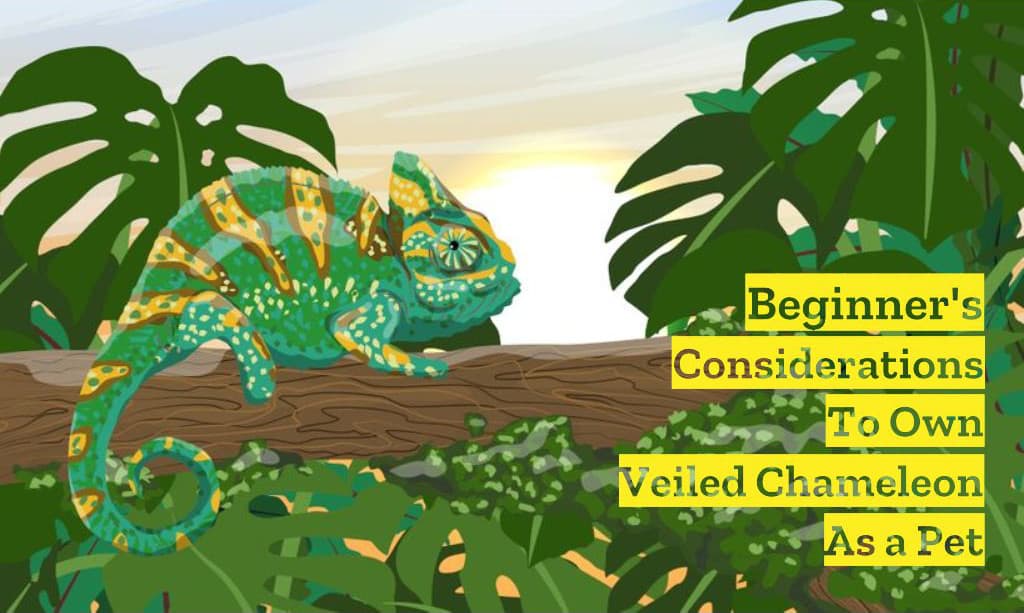
Many people who own a veiled chameleon as a pet have difficulty finding information about veiled chameleon care, especially if they are new to the reptile. The main reason is that they are a little more challenging to care for than other reptiles and require special lighting and diet considerations.
If you are getting a veiled chameleon for young children or as a novice reptile enthusiast, you may read on to find out more if a veiled chameleon is a right pet for you.
Let’s get started!
- Your Experience Having a Lizard as Your Reptile Pet
- Enclosure Setup Considerations if You Are New to Veiled Chameleon
- Do You Have Enough Space for Your Veiled Chameleon Cage?
- What Do You Need to Know about Diet for Veiled Chameleon as a Beginner
- Get Ready for Health-Related Issues
- Do You Have a Proper Budget to Own a Veiled Chameleon?
- Rules And Regulations (CITES) – Every Novice Veiled Chameleon Owner Should Know
- Summary: Can A Veiled Chameleon Make A Good Reptile For Beginners?
Your Experience Having a Lizard as Your Reptile Pet
Having a pet chameleon is pretty challenging and requires some experience in keeping reptiles. Generally, keeping it healthy and happy requires a lot of effort, money, and time from the owner.
However, if you have experiences with other reptile pets, such as bearded dragons or leopard geckos, it certainly helps.
Therefore, you need to research beforehand if you are a newbie to this pet. It is rewarding to learn as much as possible about this unique and beautiful reptile and to prepare all the necessary supplies before getting one. It can be an exciting and satisfying experience for the owner.
Also, it is crucial to take all necessary precautions when caring for chameleons because they are sensitive creatures, especially if you do not have experience with reptile pets. They need nutritious food, multivitamins, mineral supplements, and an appropriate habitat setup to stay healthy and happy.
Enclosure Setup Considerations if You Are New to Veiled Chameleon
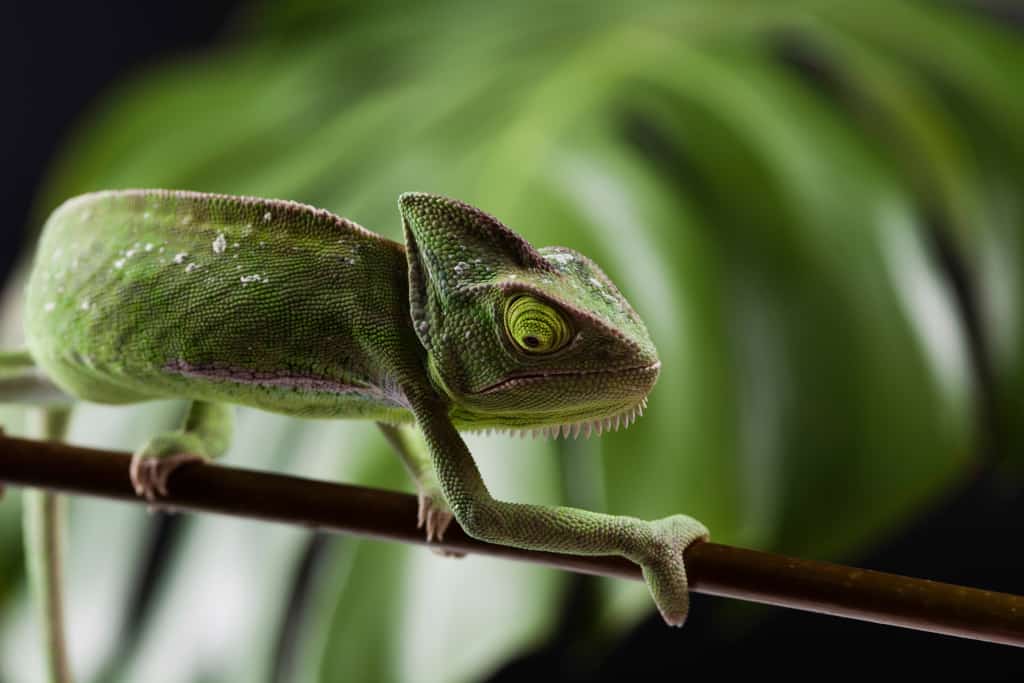
Habitat and Housing
The veiled chameleon is native to the Yemen rainforest, at the Southern Arabian Peninsula, along the Gulf of Aden. Therefore, you need to understand the wild habitat all year long for this species and duplicate one as close as possible under your care.
It is crucial to provide a suitable husbandry environment for them to feel at home and make it comfortable. For instance, a chameleon can live well in an enclosure with the appropriate plants, branches, vines, etc., for climbing and hiding. This setting will give him a feeling of being in his natural environment, which he needs.
Temperature and Heating
Veiled chameleons are cold-blooded animals, and they need a proper basking area to regulate their body temperature.
The enclosure temperature setting will depend on the climate of your location. It means that you need to get the proper heating accessories and equipment for the settings to ensure that the temperature is correct and consistent throughout the day, regardless of the weather.
For reptiles such as the Yemen chameleon, it is better to get separate lighting and heat sources so that they are easier to control. If you have a cooler ambient temperature, you need to consider the nighttime temperature in the Yemen rainforest in the wild and formulate the natural environment in captivity.
Compared to other reptile pets, using high-precision instruments such as a dimming thermostat to control the vivarium temperature are better for the veiled chameleon cage because this lizard’s health is susceptible to its surrounding temperatures.
With a proper thermostat, you can control and adjust the basking bulb to generate heat consistently, night and day. There are programmable thermostats in the market that you can purchase to do the work automatically. Eventually, it will save you time and trouble.
On top of the thermostat, you need thermometers for temperature monitoring throughout the day. It is an excellent approach to have at least two thermometers by securing one close to the basking spot and one at the shaded or cool area. When you notice an inconsistency in the temperature, you may need to adjust the fixture or heating configurations.
One of the serious mistakes that a beginner makes is that they forget to check the settings and change it accordingly when the weather changes such as a transition from one season to another. For example, you may need to adjust or replace the heat source during the winter season to keep the enclosure warm.
As a beginner, you need to develop a habit of reading the thermometers when viewing or feeding the chameleon to ensure that the habitat temperature is always correct. It is not as easy as set-and-forget. Other than that, it also means that you need to invest more effort and money in the equipment to fine-tune for the optimum temperature.
Lighting and UVB Source
The light bulb is the primary source of UVB for reptile Pro Vitamin D to Vitamin D3 synthesis to absorb calcium. A regular UVB bulb may not emit sufficient UVB rays for Vitamin D3 synthesis in the veiled chameleon bloodstream. It will eventually lead to unnecessary illnesses such as metabolic bone disease (MBD). Therefore, it is advisable to use a high-output UVB bulb, which usually is slightly pricy.
It is an expert practice to get a 5% or 10% UVB bulb for the lighting, depending on your vivarium setup. A proper lighting setup is a more advanced topic that we cover separately in lighting and UVB bulb selection for veiled chameleon.
Many beginners do not know that they need to change the UV bulb as manufacturers’ recommendation even though the light is still working. The main reason is the effectiveness of UVB will be dropping or even stop functioning well over a period of time. To ensure a good supply of UVB lighting, you should measure the UV index from time to time using a UV meter.
However, if you do not have a budget for a UV meter, it is best practice to set a reminder on your phone or keep a logbook for the light bulb replacement schedule based on the manufacturer’s manual.
You can use an automatic timer for lighting control to switch on and off the UVB light. For veiled chameleons, always remember that an average of 12 hours of UVB lighting is always required.
Plants
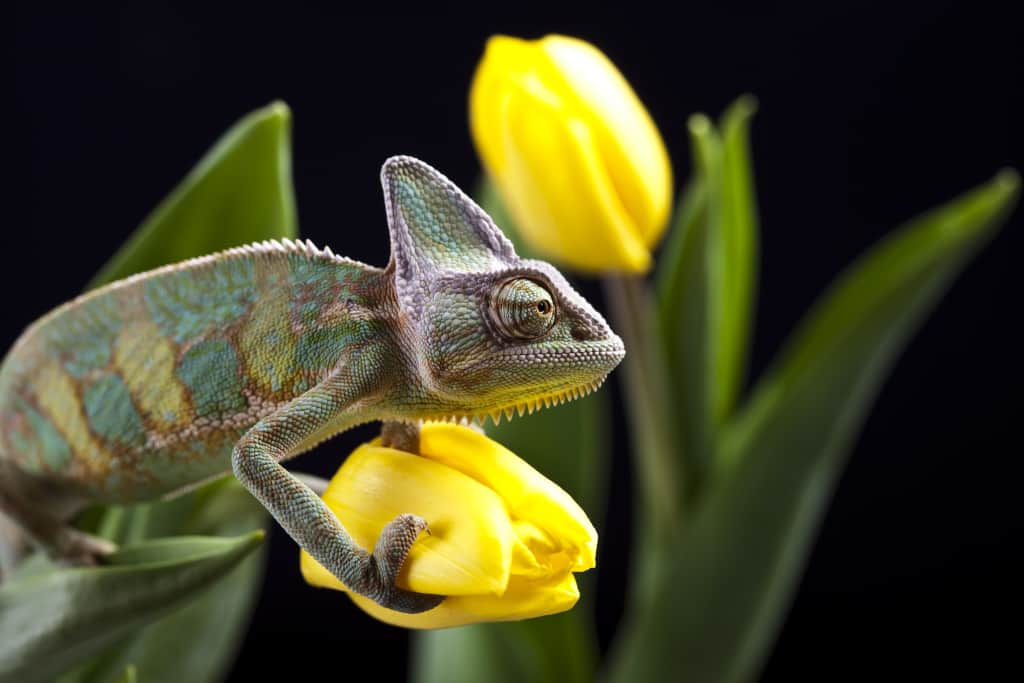
You will need different types of live plants to create the habitat for your veiled chameleon. Usually, the reptile owner will use the main trunk as the backbone of the overall habitat, trailing plants for the climbing vines, hiding places, or drinking surfaces.
There are several types of plants that work well as shades and hiding spots for your veiled chameleon. The concern is whether you can source them locally. Also, always keep in mind that do not use sharp climbing branches or objects that may hurt your cham.
To begin with, try to consider Ficus trees and Golden Pothos. Ficus trees, tree branches, and vines can work as the backbone of the foliage for climbing, while Golden Pothos can serve as hiding places and function to drip the water for the veiled chameleon to drink. If you do not like these plants, you may consider other plants.
You may use a variety of landscaping plants. However, you need to ensure that the plants you plan to use are non-toxic, sturdy, easy to maintain, and available in your local pet store or community.
For a first-timer who owns a reptile, you will need to consider the time factor for habitat maintenance, such as removing the dropped leaves, being easy to cut, or replacing the plants whenever required. Hence, choosing good plants that are easy to maintain for your veiled chameleon is crucial other than for viewing.
Water Supply and Misting Systems
Veiled chameleons live in the rainforest along the Yemen mountainous regions, and they require a considerably high humidity environment to stay happy and healthy.
It is worth considering the automatic reptile misting or dripping system as part of the setup for the veiled chameleon enclosure. It will help provide consistently on-time misting for your pet, especially if you are busy and not always home.
A hygrometer is another excellent tool to monitor humidity. Again, it is a must-have item.
If you are new to reptiles, please do not mist the water directly onto the veiled chameleon’s head or body to wet him or provide him the drink with a spray bottle. It will not be helpful and only will stress him up and create unnecessary health consequences. Do not worry about providing standing water because the pet chameleon will drink the water droplets from the leaves or walls.
Do You Have Enough Space for Your Veiled Chameleon Cage?
It is better for you to get at least a 12” x 12” x 24” (WxDxH) terrarium, even if you are planning to get a female veiled chameleon. You need to plan ahead and get a bigger tank even if you are getting a baby or juvenile because this reptile grows considerably fast into an adult within a year.
A good practice is not changing the terrarium too often as it will cost you more in the long run. Besides, you will create more stress for your veiled chameleon if you switch to a new environment in a short period as it needs time to adapt.
Unlike housing other reptiles, you need a vertical cage when housing a veiled chameleon, as this is an arboreal animal. So, you need to consider a ventilated environment with a mesh on top of the cage. Keep in mind that you need a space to place the doom or reflector for the heat or light sources. Do not forget the extra area for the power adapter, extensions, cabling, and wiring.
Usually, it is practical to place the veiled chameleon cage against the wall or at the corner of the room to avoid the excessive traffic that might create stress for your beloved pet. Therefore, you need to make sure you have space for the front opening and at least one ventilated side for proper airflow.
Unlike other reptiles that require a top opening tank that usually requires a smaller area, you need to consider a slightly bigger space for the veiled chameleon cage.
What Do You Need to Know about Diet for Veiled Chameleon as a Beginner
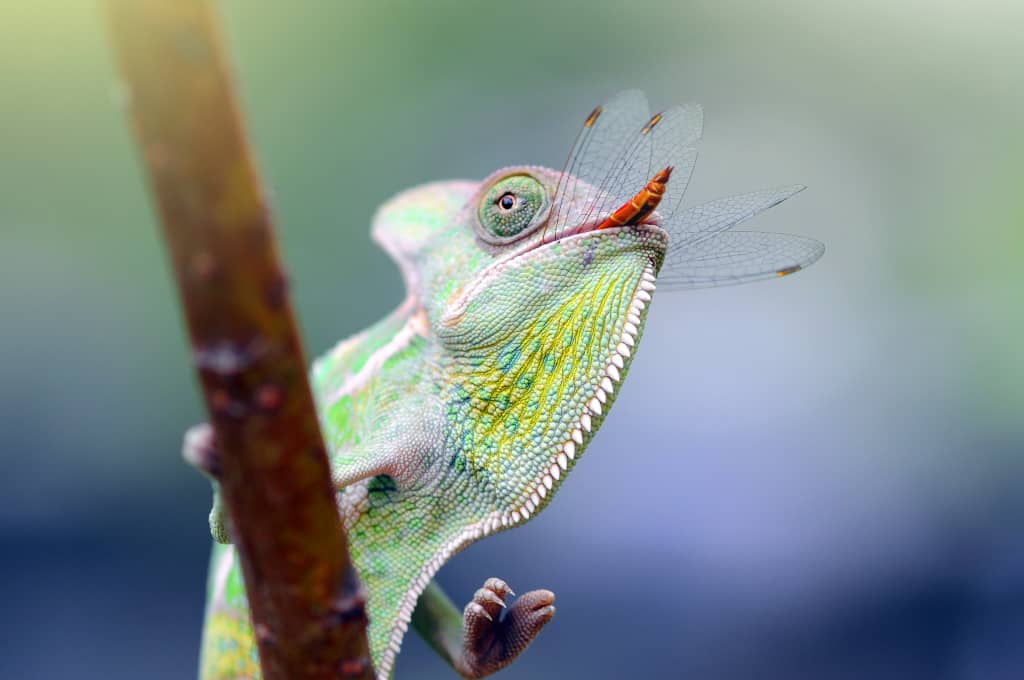
Beginners need to pay some attention to the food of their reptile pets. A balanced diet is key to veiled chameleon health.
Technically, a variety of insects should be the primary food for your veiled chameleon. The live feeders are mainly crickets, Dubia roaches, and mealworms. Occasionally, you can provide alternative food such as roaches, waxworms, and superworms that are fatty.
Just bear in mind that you should gut-load the insects before providing them to your pet to ensure they are rich in nutrients. Gut loading means feeding the insects with nutritious food before passing them to the cham.
Other than that, you need to provide additional vitamins and supplements to your reptile by dusting the insects lightly twice a week before placing them on the food dish.
It is prudent to spend some time cutting the fruits and leafy green vegetables into pieces to feed your chameleon; even it can eat the live leaves and greens in the terrarium. That will provide additional nutrients for them.
Meanwhile, do not forget to remove the excessive live food every day. Additionally, always remember to clear the unfinished vegetables or fruits within 24 hours from the food dish.
If you are getting an adult chameleon, it is easier and more flexible because you can feed him every other day. However, if you have a young or juvenile cham, you will have to supply him the food once or twice a day to ensure it thrives, especially if you have a baby chameleon. It will need more protein for growth and development.
It would be best if you have time to prepare food for your pet every day. Or you may need to have a friend or family member to back you up for this task. Otherwise, an automatic feeder may also help.
Do not underestimate the work that you need to do in food preparation for your cham. It would be best if you always plan for the food supply, which includes making sure that there is no interruption of the sources of the live feeders.
By the way, wild-caught insects are not advisable because they might carry parasites that will make your pet sick.
Get Ready for Health-Related Issues
Many experienced reptile keepers will avoid many health-related issues by having a proper cage set up and a good diet plan for the pet. However, if you are new to this reptile, you need to plan and be cautious about this. A sick chameleon will cause you to spend more on vet visits and treatments. At the same time, and you may lose interest in keeping a reptile.
You can always avoid health problems such as stress, malnutrition, dehydration, and injuries if you spend more time studying their natural habitat in the wild and create an identical environment for them. Feeding a veiled cham with proper food is also crucial to make sure that it is healthy.
Prevention is always better than cure. Every experienced chameleon owner always foresees the circumstances, thinking in advance about proper husbandry, and crafts a care plan before getting a veiled chameleon. Hence, this is no exception if you are new to a veiled chameleon.
It is good to spare some time to read more, get the cage setup ready, and bring in your pet when everything is in place.
Do not forget to list down all of your local vets that have experience in treating chameleon diseases. It is a precaution, just in case you need to visit them if any unforeseen circumstances arise. The list will be helpful for you.
Do You Have a Proper Budget to Own a Veiled Chameleon?
Extra budget allocation to owning a veiled chameleon is always a good practice; especially if you are new to this reptile hobby. It is not as simple as purchasing a single veiled chameleon kit, hosting the lizard in the cage, and hoping that you will have a colorful, active, and vibrant pet.
There are many factors you need to consider for a tank setup as a beginner. Depending on the budget you have, you can have the essential supplies for the regular work while you have to work for most of the tasks manually. On the other hand, the advanced equipment will cost you more, but they can automate most of the work, such as an automatic misting system to create a sustainable humid environment.
There is a balance you need to make between spending more or working more. There are advantages to doing the work manually because you can learn how to interact with the reptile, and there is a chance for you to monitor their behavior and health condition.
On top of that, you need to spare the cost of purchasing the veiled chameleon.
Rules And Regulations (CITES) – Every Novice Veiled Chameleon Owner Should Know
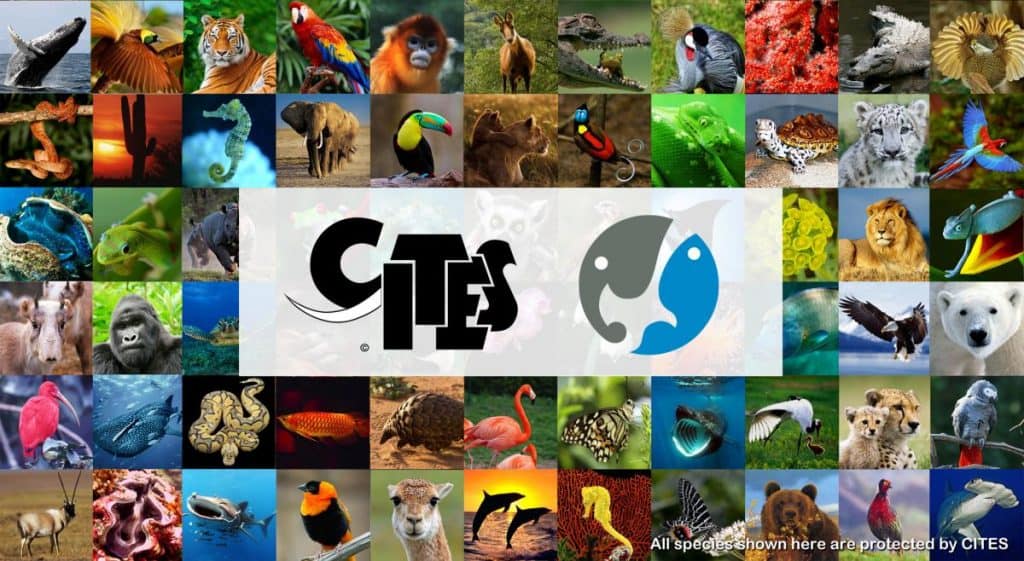
United States is part of the CITES (Convention on International Trade in Endangered Species). The veiled chameleon is listed as a CITES II animal, which means they are under protection. That means it is illegal if they are wild-caught pet chameleons.
Under the CITES rules, you may own, breed, and trade the veiled chameleon freely as a pet in the United States with the proper documentation for CITES II species. If you buy one from a pet store or breeder, always check with them to provide you with the appropriate paperwork. That is a simple document stating the relevant information about that lizard species and its owners (new and previous).
The local rules and regulations might change from time to time. Please check out the latest information from the local authority, breeders, or pet stores.
Summary – Can A Veiled Chameleon Make A Good Reptile For Beginners?
Generally, taking care of a veiled chameleon is an advanced topic for many reptile hobbyists. It might sound challenging to own this exotic pet. However, a beginner can always do well with the captive-bred chameleon with detailed study and preparation work.
It is crucial to get everything in place before purchasing your first veiled chameleon. With this, you can avoid any unnecessary troubles and save a lot of time and effort.
Doing your research before owning a veiled chameleon can be fun and rewarding. We hope this guide explains the major concerns about having a veiled chameleon as your first reptile pet, so you don’t make any costly mistakes when buying or setting up their habitat.
Veiled chameleons can always be great pets for beginners!
Recommended Reads:
